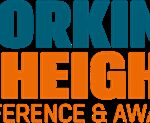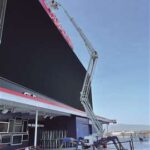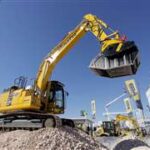How Much Does a Scissor Lift Cost?
The cost of a scissor lift can vary significantly depending on various factors, such as the model, specifications, features, and whether you’re buying new or used. Whether you’re using it for short-term projects, rough terrain work, or simply needing indoor and outdoor functionality, knowing the price range of different types of scissor lifts will help you make an informed decision.
Let’s dive into the estimated cost ranges for scissor lifts in 2025, based on their type, size, and usage.
1. Electric Scissor Lifts
Electric scissor lifts are primarily used for indoor tasks, including warehouse operations, maintenance, and light construction. These models are ideal for short-term projects where mobility in tight spaces and weight capacity are important.
-
Small, Compact Electric Scissor Lifts
Cost Range: $8,000 – $15,000
These electric scissor lifts typically have a working height between 20 to 30 feet (6 to 9 meters) and are designed for light indoor tasks. Their compact design and narrow width make them perfect for maneuvering in tight spaces, such as narrow aisles and small rooms. They are well-suited for projects where the lift height isn’t excessively high, but maneuverability and ease of operation are paramount. -
Mid-Range Electric Scissor Lifts
Cost Range: $15,000 – $30,000
For projects that require a bit more reach and heavier lifting, mid-range electric scissor lifts provide working heights ranging from 30 to 50 feet (9 to 15 meters). These models are designed to handle slightly heavier loads—up to 1,000 lbs (450 kg)—and can be used both indoors and outdoors in controlled environments. Electric lifts are quiet, eco-friendly, and low-maintenance, making them suitable for various types of jobs, especially those that require high maneuverability in confined spaces.
2. Diesel & Hybrid Scissor Lifts
Diesel and hybrid-powered scissor lifts are designed for more rugged applications, especially those in outdoor environments. Whether you’re working on construction sites or areas with uneven terrain, rough terrain scissor lifts are built to perform.
-
Entry-Level Diesel Scissor Lifts
Cost Range: $20,000 – $40,000
These lifts are made to handle rough terrains and are suitable for tasks that require more height and weight capacity. With working heights between 40 to 50 feet (12 to 15 meters), they offer a substantial reach and are designed for outdoor work. These lifts are capable of navigating uneven surfaces and are robust enough to handle demanding environments. -
High-End Diesel & Hybrid Scissor Lifts
Cost Range: $40,000 – $70,000
High-end models are designed to tackle the most demanding jobs. With working heights of up to 60 feet (18 meters) or more, these lifts are built for large construction projects, utilities, and industrial tasks. Diesel-powered lifts offer greater power, mobility, and durability, which is why they come at a higher cost. These lifts are equipped with features to help tackle rough terrain and challenging job sites.
3. Used Scissor Lifts
Buying a used scissor lift can be an excellent way to save money, especially if you’re working on short-term projects or don’t need the latest model. However, the cost of a used scissor lift depends on the model, age, and condition of the equipment.
-
Used Electric Scissor Lifts
Cost Range: $5,000 – $12,000
Used electric scissor lifts provide a cost-effective solution for those needing a lift for indoor applications. Although they may show signs of wear, well-maintained models can serve just as effectively as new ones. For businesses or contractors with budget constraints, buying a used electric lift can be an economical option. It’s especially useful for light-duty tasks such as maintenance, light construction, and installations in warehouses, shopping centers, or factories. -
Used Diesel or Hybrid Scissor Lifts
Cost Range: $10,000 – $25,000
Diesel and hybrid-powered scissor lifts generally have a longer lifespan and can take on tougher tasks. However, when purchasing a used model, consider its hours of use, age, and overall condition. These lifts still provide great value for outdoor work, such as construction and heavy-duty maintenance. You can expect to pay significantly less for a used diesel lift compared to a new one, while still benefiting from its ruggedness and high performance.
Factors Affecting the Cost of a Scissor Lift
There are several factors that determine the price of a scissor lift. Below are some of the most important elements to consider when purchasing or renting a scissor lift:
-
Brand and Model
Well-known brands like JLG, Genie, and Haulotte are often priced higher due to their reliability, safety features, and innovation. These brands are trusted for their performance and are often seen as the standard for scissor lifts. -
Working Height & Lift Capacity
The lift height directly affects the price. Scissor lifts with a higher working height and greater load capacity will generally cost more. For example, a scissor lift with a 50-foot working height will cost more than one with a 30-foot working height. Similarly, a lift with a higher weight capacity—able to carry more equipment and workers—will also come at a premium price. -
Power Source
Diesel and hybrid lifts are typically more expensive than electric ones, given that they can handle more demanding applications and operate in more challenging environments, such as rough terrains. Electric scissor lifts, on the other hand, are typically more affordable and suited for indoor work in stable conditions. -
Optional Features
Scissor lifts equipped with advanced features, such as automatic leveling, enhanced safety systems, or larger platforms, will come at a higher price. While these features can improve the ease of use and safety, they may increase the overall cost of the lift. The added features may be a necessity for certain applications, but for those on a tight budget, it’s important to weigh the cost against the potential benefits.
Additional Costs to Consider
In addition to the upfront cost of purchasing a scissor lift, there are several other expenses you may need to consider:
-
Average Scissor Lift Rental Cost
Renting a scissor lift is a great option for short-term projects. Rental costs typically range between $100 and $400 per day, depending on the lift’s size, specifications, and duration of the rental. For long-term rentals, you can expect to pay between $1,500 and $3,500 per month. The rental cost is affected by the lift height, weight capacity, and whether you are renting a standard or rough terrain scissor lift. -
Maintenance & Repairs
While electric scissor lifts generally require less maintenance than diesel-powered models, it’s important to factor in maintenance costs. Regular servicing, such as tire replacement and battery maintenance, will incur additional costs over time. Diesel models also require more upkeep to ensure they are operating at peak performance. The cost of repairs and maintenance depends on the model and frequency of use. -
Transporting the Lift
Moving a scissor lift from one job site to another can incur additional costs. The transportation cost will depend on the distance, size of the lift, and whether a flatbed truck or specialized trailer is required.
Scissor Lift Rental: Renting vs. Buying
For many businesses, especially those with short-term projects, renting a scissor lift is a more cost-effective solution. Renting allows you to access high-quality equipment without the large upfront investment. It’s ideal for tasks that require a specific lift type for a limited time.
However, if you frequently need a scissor lift, buying one may be a more economical long-term option. Purchasing a lift gives you the flexibility to use it whenever necessary, without worrying about rental fees. If you buy a used scissor lift, you can save on costs while still getting reliable performance for indoor and outdoor applications.




